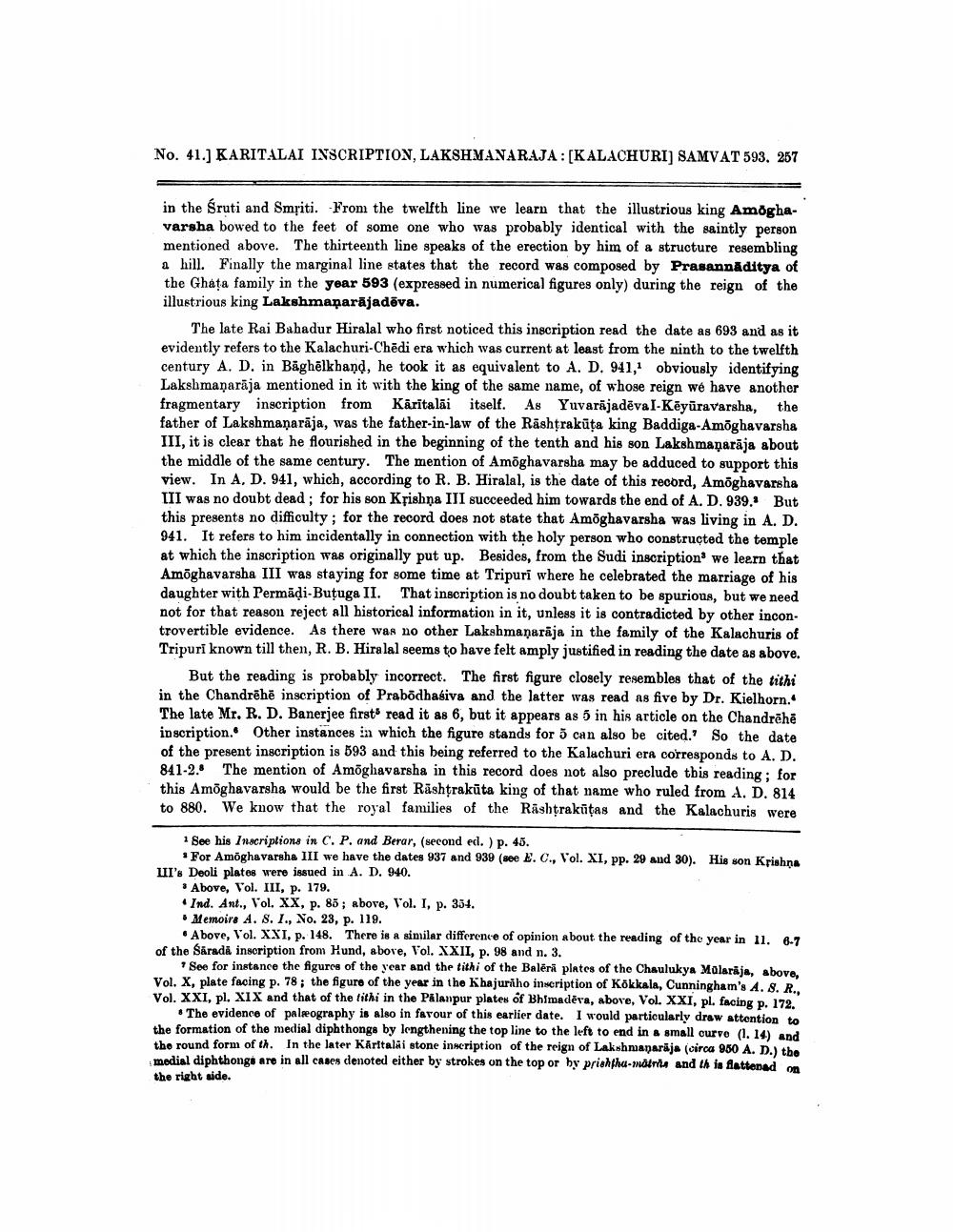________________
No. 41.) KARITALAI INSCRIPTION, LAKSHMANARAJA: [KALACHURIJ SAMVAT 593. 257
in the Sruti and Smriti. From the twelfth line we learn that the illustrious king Amoghavarsha bowed to the feet of some one who was probably identical with the saintly person mentioned above. The thirteenth line speaks of the erection by him of a structure resembling a hill. Finally the marginal line states that the record was composed by Prasannaditya of the Ghata family in the year 593 (expressed in numerical figures only) during the reign of the illustrious king Lakshmanarājadēva.
The late Rai Bahadur Hiralal who first noticed this inscription read the date as 693 and as it evidently refers to the Kalachuri-Chēdi era which was current at least from the ninth to the twelfth century A. D. in Băghēlkhand, he took it as equivalent to A. D. 941, obviously identifying Lakshmanarāja mentioned in it with the king of the same name, of whose reign we have another fragmentary inscription from Karitalãi itself. As Yuvarājadēva l-Kěyūravarsha, the father of Lakshmanarāja, was the father-in-law of the Rashtrakūta king Baddiga-Amõghavarsha III, it is clear that he flourished in the beginning of the tenth and his son Lakshmanarāja about the middle of the same century. The mention of Amõghavarsha may be adduced to support this view. In A, D. 941, which, according to R. B. Hiralal, is the date of this record, Amõghavarsha III was no doubt dead; for his son Krishna III succeeded him towards the end of A. D. 939. But this presents no difficulty; for the record does not state that Amoghavarsha was living in A. D. 941. It refers to him incidentally in connection with the holy person who constructed the temple at which the inscription was originally put up. Besides, from the Sudi inscription we leern that Amöghavarsha III was staying for some time at Tripuri where he celebrated the marriage of his daughter with Permādi-Buțuga II. That inscription is no doubt taken to be spurious, but we need not for that reason reject all historical information in it, unless it is contradicted by other incontrovertible evidence. As there was no other Lakshmanarāja in the family of the Kalachuris of Tripuri known till then, R. B. Hiralal seems to have felt amply justified in reading the date as above.
But the reading is probably incorrect. The first figure closely resembles that of the tithi in the Chandrēhē inscription of Prabodhaśiva and the latter was read as five by Dr. Kielhorn. The late Mr. R. D. Banerjee first read it as 6, but it appears as 5 in his article on the Chandrēhē inscription. Other instances ia which the figure stands for 5 can also be cited.' So the date of the present inscription is 593 and this being referred to the Kalachuri era corresponds to A. D. 841-2. The mention of Amõghavarsha in this record does not also preclude this reading; for this Amõghavarsha would be the first Rashtrakūta king of that name who ruled from a. D. 814 to 880. We know that the royal families of the Rashtrakūtas and the Kalachuris were
1 See his Inscriptions in C. P. and Berar, (second ed.) p. 45.
* For Amoghavarsha III we have the dates 937 and 939 (see E.C., Vol. XI, pp. 29 and 30). His son Krishna LII's Deoli plates were issued in A. D. 940.
* Above, Vol. III, p. 179. * Ind. Ant., Vol. XX, p. 85; above, Vol. I, p. 354. . Memoirs A. 8. I., No. 23, p. 119.
• Above, Vol. XXI, p. 148. There is a similar difference of opinion about the reading of the year in 11. 6-7 of the Särada inscription from Hund, above, Vol. XXII, p. 98 and n. 3.
* See for instance the figures of the year and the tithi of the Baléri plates of the Chaulukya Molaraja, above, Vol. X, plate facing p. 78; the figure of the year in the Khajuraho inscription of Kokkala, Cunningham's A. 8. R.. Vol. XXI, pl. XIX and that of the tithi in the Palanpur plates of Bhimadeva, above, Vol. XXI, pl. facing p. 172.
The evidence of paleography is also in favour of this earlier date. I would particularly draw attention to the formation of the medial diphthongs by lengthening the top line to the left to end in a small ourvo (1. 14) and the round form of th. In the later Karitaldi stone inscription of the reign of Lakshmanarja (circa 950 A. D.) the medial diphthongs are in all cases denoted either by strokes on the top or by prishthu-nder and this flattened on the right side.




